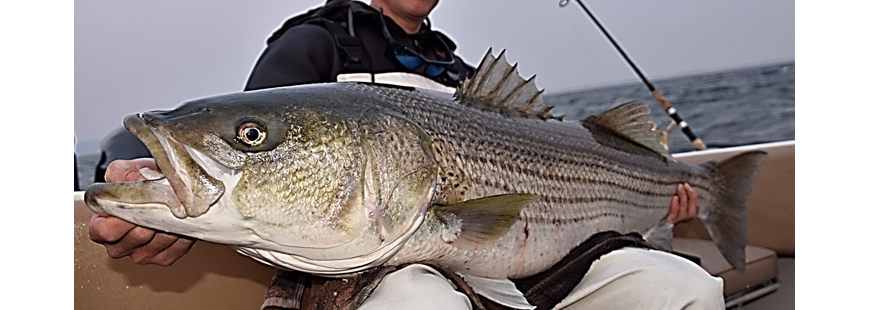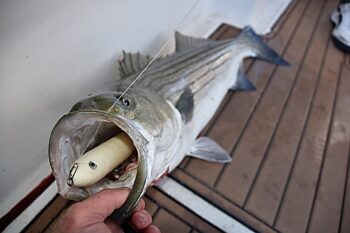On and Off the Water Observations of 2023’s Fishing Season
There aren’t many anglers around who wouldn’t agree that the striped bass run in the New York Bight this fall was downright EPIC. And the spring/early summer? ‘Twas really good too. Indeed, I said similar things last year, but yeah, man… this year was kinda ridiculous.
Of course, it wasn’t as loaded in other regions, but those areas to the north did seem to experience an increase in striped bass availability. And, well, it’s December, and it seems like there’s a significant aggregation of large fish down south now too. To be clear though, everyone has their predisposed contacts, and as such, there will always be the “well, my friend said” opposition to anything like that.
Here though? It’s hard to articulate just how good it was. So many striped bass feeding frenzies that the Nat Geo references became cliché. Whether that’s related to a general increase in abundance, a few good year classes, the Hudson River’s proximity, bait concentrations, or factors that we just can’t pinpoint, well, it’s hard to say. But there were a LOT of fish around, of all sizes.
Some are warning that such aggregations are not reflective of a significant increase in striped bass numbers, that they are small and localized, and that fishing is “pretty bleak” in most places. But from central Long Island to central New Jersey, the body of fish has been absolutely massive.
Still, the stock is indeed “overfished” (under the spawning stock biomass threshold that determines a healthy stock), and really some areas don’t seem to be benefiting from rebuilding for whatever reason (e.g., a general shift northward, localized overfishing, invasives, etc.).
Localized or not though, since 2019 spawning stock biomass overall IS on the rise. So, let’s get beyond the politics and just agree that, for whatever reason, the stock is currently rebuilding (read: increasing) –for now anyway.
Before moving on, it’s important to acknowledge that there are real recruitment (read: reproduction/juvenile survival) problems in the main producer area, the Chesapeake Bay. It’s a related but separate issue because, for one, poor young-of-the-year indices are a recent occurrence, which don’t necessarily reflect whether or not we will reach a biomass target by the mandated rebuilding deadline of 2029. And, there IS no “stock/recruitment” relationship with striped bass (relationship between spawning stock biomass and young-of-the-year production/survival). I don’t think we have space to get into that here. Perhaps in a future piece. But it’s definitely something to keep in mind during all of this.
Changes
It was last December that I wrote about the 28 to 35″ striped bass slot limit implemented in the 2020 fishing year.
Much has changed since then. For one, while, yes, that constraining slot limit did reduce fishing mortality, according to a stock assessment update, it didn’t reduce it enough. At least not enough to rebuild the stock to the biomass target by 2029.
And so, managers implemented emergency regulations mid-season, reducing the slot size to 28 to 31″, giving anglers a 3″ allowance on what they can harvest. Of course, as intended, this made it really difficult to retain a “keeper” at times. In my region, near impossible, for most of October anyway. Just this week the Atlantic States Marine Fisheries Commission (ASMFC) incorporated the 28 to 31″ slot into its striped bass fishery management plan. On paper, it does appear to be working, although we’ll need to wait until the October stock assessment update to be sure we’re on track to rebuild to that biomass target by 2029.
Observations
I fish striped bass almost exclusively from April through June, transitioning over to tuna by July. Once that starts to wind down in October, I shift to striped bass again, and am pretty much out targeting striped bass EVERY day, save the ones when the weather just doesn’t allow it.
The following are some strictly anecdotal observations, restricted to time and area.
Starting that first week of October here, there were an increasing number of large striped bass targeting adult menhaden schools. Not unusual for this time of the year, although the numbers certainly were. What was very different is that for most of October, in my region, you really couldn’t find a “keeper” (28 to 31″ slot fish). It was, for all intents and purposes, a catch-and-release fishery.
Yet, the daily crowds were undoubtedly the largest I’ve ever seen them. If the weather was nice, you could honestly count 200+ boats. We’re not gonna get into the “no one works anymore” stuff here, but the point is, there was a ton of traffic when it was really clear that no one was catching any keepers.
Sure, those folks could have been out there simply to try and get a keeper, however low the chances were, but I don’t think so. More than likely, they were out there for sport, and/or to get their hero pics (which was certainly why we were out there).
While sure there were guys throwing plugs or dropping flutter-spoons, it was pretty clear that most of fleet were “snag-and-drop” fishing. In other words, ripping a weighted treble hook though a menhaden school, sticking one, letting it swim and waiting for a striped bass to eat it. What do I mean by most? I dunno, I’d guess around 80-90%?
If you’re up on your regs, which you should be, that’s illegal in New York, and, well, everywhere else. In fact, fishing any live or dead bait on a treble is prohibited. The only thing you can use is an inline circle hook, meaning the point of the hook is not only bent in, it’s in line with the shank. Which I suppose makes sense, as it’s more likely you’re going to gut-hook a striper on a treble than if you were using an inline circle hook. A solid regulation intended to reduce dead discards. IF…it were at all enforceable.
The problem is, it’s efficient, and unless there are repercussions, there’s no reason for anglers NOT to do it. If there were any boardings during the run – which I may be wrong, but there sure didn’t appear to be, and someone were to have gotten cited for snag-and-drop, well, all the angler had to say is that they were targeting bluefish (even though there weren’t really bluefish around, but enforcement officers don’t know that, nor could they prove it even if they did).
Even before this “feel-good” regulation went into place, law enforcement reps were clear, on the record, about the enforcement and compliance problems such regs pose. Many folks, Commissioners specifically, claimed that regardless of enforcement issues, most anglers would be complaint just because it was the right thing to do. From what I see though, this just isn’t true.
In case you hadn’t already drawn the conclusion on your own, there were a LOT of dead discards this October. Every day we’d see several floaters, plus a LOT of fish that came over boats’ gunnels pretty darn bloody.
I certainly don’t want to blame all of that on snag-and-drop, because the truth is that if it’s done right, it’s probably less detrimental than fishing a circle hook wrong. To be clear, if you don’t let the fish run with the bait (i.e. swallow it) for several seconds, the treble would stick in the lip/jaw, not the gut or gills. But the “bow-to-the-cow stuff”? Well, that was kind of the old way of doing things because most folks were keeping big fish when it was legal to do so.
At least with trebles, most of the time you get them out with a long pair of needle-nose pliers, or one of the many dehooking devices you’ll find online. If a big striper inhales a menhaden fished on an inline circle hook, and for one reason or another, it doesn’t slide out of the gullet like it’s supposed to (ahem, which does happen), well, you’re never getting that hook out, and that fish is pretty much dead.
Lastly, just because you fish plugs, even the single-hook ones, this doesn’t get you off the hook (pun intended). I hate to admit it here, but we do gut-hook/gill-hook fish on plugs. Truthfully that happens a LOT, particularly when large stripers are on menhaden, and especially when you have inexperienced anglers on board.
And just to be clear, if you’re one of the fly-gear-only guys, you aren’t innocent either. Quite a bit of my fall business is flyfisher-folk trying to stick a trophy on a fly. Well, let me tell ya…when you’re doing the typical strip-strip-pause technique, and they inhale it on the pause? That fish is hooked deep, and/or in the gill. And that’s NOT good.
All of this stuff gave me pause this year. And frankly my conscience might have been bothering me some. Because if there IS a problem, well then, I’m certainly part of it.
I’m going to circle back around to that.
Stay tuned for part two, where I’ll discuss some possible takeaways and what it all might actually mean on the management/rebuilding side of things.




I’VE BEEN WRITING AND COMPLAINING ABOUT ROCKFISH MORTALITY FOR A LONG TIME. I LIVE ON CHESAPEAKE BAY. I KNOW CAPT JOHN HAS a POINT OF VIEW DIFFERENT FROM MINE (I WOULD IMPOSE A MORATORIUM), BUT IT’S REFRESHING TO SEE SOME HONESTY ABOUT THE MORTALITY LEVELS WITH SUPPOSED CATCH AND RELEASE. IT IS DISGUSTING TO SEE CHARTER CUSTOMERS HOLDING ROCKFISH “COWS” OUT OF THE WATER LONG ENOUGH TO TAKE THEIR TROPHY PHOTO. IT WOULD ONLY BE FAIR TO SEE THE FISH HOLD THE FISHERMAN UNDER THE WATER FOR THE SAME TIME IT TAKES TO GET THAT “PERFECT” PHOTO.
How can you say with a straight face that fishing single hooks is as detrimental as a snag treble? I mostly jig soft plastics and I very rarely gut or fill hook fish. If so it is easily popped free. Now live lining even with circles is a different animal and in the summer months seeing floaters especially around the live lining fleet is very common. Not so much around the jiggers. Interesting to see how you rectify these to a solution.
I didn’t say they are AS detrimental as trebles. Just said they gut hook fish too. Speaking personally, I use a single hook in the back, treble in the front. The treble isn’t the problem. It’s the back hook that ends up in the gullet. Tends to happen more when the fish are on big bait (menhaden).
Can I get some that’s a big fish they taste good I would sure like to try some if you send it to me thank you very much
Yes, pls check your mailbox
I have been fishing the chesapeake bay since the late seventies. There is no reason for catch and release which ultimately kills fish. Never allow it on my charter boat and never will
This is why I only fish plugs with a single treble in front and a flag in the back. Sure I may miss a few fish, but I am good with this..I have my plug manufacture modify plugs for me this way. Wish more builders would go this route. I asked the builder of GRS to do this and it went no where. He was more interested in the money aspect then the bass resource.
So John, Your charter catches their limit of striped bass and you go home?
Shut the spawning grounds fishing down, at least partially, until they move out into the bays and ocean. Raritan Bay, the Chessy, and a few lesser bays. Additionally, 1 size / slot fits all, all year, all waters.
Shut the spawning grounds fishing down, at least partially, until they move out into the bays and ocean. Raritan Bay, the Chessy, and a few lesser bays. Additionally, 1 size / slot fits all, all year, all waters.
If we want to save striper fishery there should be a 5 year ban on all striper fishing and a serious penalty(fine) for anyone caught fishing for them.I am tired of state and the federal fishery management council not doing their job. As an example I live near Cape Cod (Mass) and we don’t even have a viable cod fishery.
Appreciate the article and your insights, as always.
There are a lot of guys who see what you saw last fall and conclude that striped bass are abundant…no problems at all…
It’s a blood sport, there’s no way around that. But it makes me think: if you are not fishing for food, then what’s the point of fishing with bait? I’m fishing for the thrill and the memory about 95% of the time, when I want fish for the table I’ll be targeting porgy’s, seabass and fluke. Sure the plug and fly guys kill fish too (as I’ve read that’s at least 10% or more of all released fish), but do they kill as near as many as the live bait snag and drop boats? I doubt it. You can take the point of view towards fishing like the charter guy above and never allow catch and release (which I think is ethical in its own way- or at the very least it’s honestly intentioned) but at the same time, there are tons of fisheries that generate enormous amounts of revenue that are based upon a catch and release model…. While I don’t see it happening, maybe we need to start thinking about making the striped bass fishery an artificial only fishery,… sure that’s unenforceable as well, but so much about enforcement is about obeying the law out of integrity, not about enforcing the law. People spend a hell of a lot of money to chase striped bass up and down the northeast coast, imagine a fishery that is super abundant and will be here for generations after we are gone- that’s what I would like to see.
How about stop in the foreigners with their spotter planes in drones all fair coast? And stop worrying about people fishing with rod and reel .
Oh what about the guys that fish from the beach cause they are boat guys they don’t count lot’s of guys driving long way to fish shut down you need to get a clue about it
Fish live herring on circle hook vs top water plugs with treble hooks. You guys must know that both methods will occasionally, but consistently over time can result in gullet hooked fish. If anyone that fishes a good bit will have to deal with it, but if the old guy on the bank is hungry, in need of a meal; the gut hook wouldn’t concern him or her in the least. It just HAPPENS.
Pingback: Sustainable Striped Bass Fishing: Ethical Angling with Live Herring -